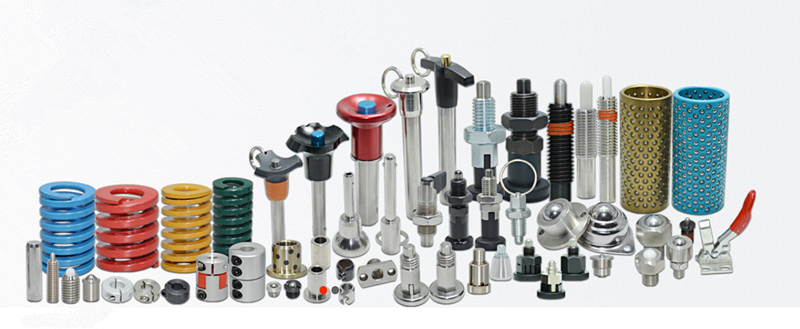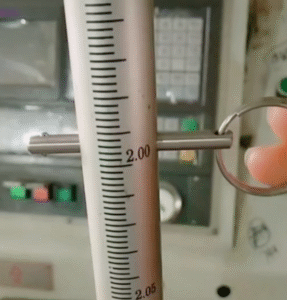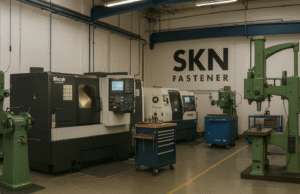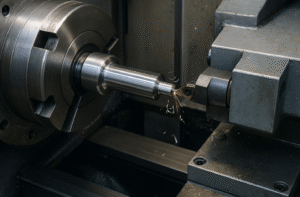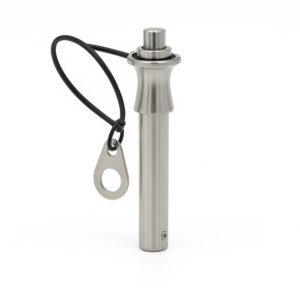Ball Lock Pins vs. Push Button Pins
In the world of quick-release fasteners, choosing the right pin can make a significant difference in performance, safety, and productivity. Among the many types available, ball lock pins and push button pins are two of the most commonly used across industrial, aerospace, and mechanical applications. While both serve the same fundamental purpose—quick, tool-free fastening—their structure, functionality, and ideal applications vary in critical ways.
If you’re an engineer, procurement manager, or OEM buyer evaluating these options, this guide will help you understand the differences between ball lock and push button pins, and when to choose one over the other.
What Are Ball Lock Pins?
Ball lock pins, often referred to as detent pins, are fasteners designed for high-strength and repetitive use. The core feature of a ball lock pin is its spring-loaded balls at the tip. When the pin is inserted into a hole, these balls retract and then expand outward to lock the pin securely in place. To remove the pin, the user presses a button or pulls a ring at the opposite end, which retracts the balls, allowing for easy extraction.
Key Characteristics:
- Locking Mechanism: Spring-loaded steel balls
- Operation: Insert to lock, press button or pull ring to release
- Grip Styles: T-handle, ring handle, L-handle, button head
- Typical Materials: Stainless steel, alloy steel, aluminum
- Sizes: Available in various diameters (commonly 1/4″, 3/8″, 10mm, etc.)
Advantages:
- High shear strength and durability
- Secure, vibration-resistant locking
- Suitable for repeated cycles
- Can be used in heavy-duty or high-precision applications
What Are Push Button Pins?
Push button pins are a type of quick release fastener that uses an internal locking mechanism activated by a flush or raised button on the top of the pin. When the button is not pressed, the locking feature holds the pin in place. When pressed, the mechanism retracts, allowing the pin to be inserted or removed smoothly.
Unlike ball lock pins which use visible side-locking balls, push button pins are more compact and visually clean, making them suitable for applications where aesthetics or limited space are considerations.
Key Characteristics:
- Locking Mechanism: Internal retractable core or spring plunger
- Operation: Press button to insert or remove
- Grip Styles: Flush button head, mushroom-style head
- Typical Materials: Stainless steel, anodized aluminum
- Sizes: Varies; often customized for specific systems
Advantages:
- Low-profile design
- Easy one-handed operation
- Clean appearance (no protruding handle)
- Ideal for compact assemblies
Side-by-Side Comparison
| Feature | Ball Lock Pins | Push Button Pins |
|---|---|---|
| Locking Mechanism | Spring-loaded side balls | Internal retractable locking core |
| Release Action | Pull ring or press top button | Press flush/mushroom button |
| Profile Design | May have handle or ring (bulky) | Compact, low-profile head |
| Strength & Load Capacity | Generally higher (for industrial load use) | Moderate; depends on design |
| Operation | Two-handed (insert & pull) in some versions | One-handed press operation |
| Best For | Heavy-duty, repeat-use industrial settings | Tight space, lightweight, aesthetic uses |
| Cost | Typically higher due to mechanical complexity | Usually lower for standard configurations |
| Common Industries | Aerospace, heavy equipment, automation | Medical devices, electronics, transport |
When Should You Choose Ball Lock Pins?
Ball lock pins are best suited for applications where:
- High load capacity is required
- The assembly must withstand vibration
- You need to frequently assemble/disassemble components
- Safety and structural integrity are a top concern
- You prefer a visible and tactile locking mechanism
Example Applications:
- Securing components in aircraft maintenance jigs
- Locking mold parts in plastic injection machines
- Positioning automation arms in robotic systems
- Connecting forklift attachments or truck body panels
Ball lock pins also often meet MIL-SPEC or aerospace standards, making them ideal for regulated industries.
When Are Push Button Pins the Better Option?
Choose push button pins if your project calls for:
- Low-profile appearance (no T-handle or ring)
- One-handed operation with minimal effort
- Installation in tight or limited-access spaces
- A focus on aesthetics or ergonomics
- Lighter loads or medium-duty fastening
Example Applications:
- Folding tables and modular displays
- Medical carts or diagnostic devices
- Lightweight enclosures or removable panels
- Public transportation seats and hardware
Push button pins are often found in industries that value design and ergonomics alongside functionality.
Other Factors to Consider
1. Environment and Material Selection
If you’re working in marine or corrosive environments, stainless steel (especially 316 grade) is preferred. For aerospace or weight-sensitive applications, aluminum or titanium may be more appropriate.
2. Budget and Volume
Ball lock pins generally cost more due to their precision components. For large-scale, cost-sensitive projects where extreme strength is not essential, push button pins may offer a better balance between performance and price.
3. Safety and Vibration
In high-vibration settings (e.g., machinery in motion, transport vehicles), ball lock pins offer superior holding strength and resistance to loosening. Push button pins may need secondary retention features in such scenarios.
Customization Options
Both ball lock and push button pins can be customized in:
- Lengths and diameters
- Materials (steel, aluminum, plastic, etc.)
- Handle shapes and colors
- Locking strength and spring tension
- Branding or part marking
Discussing your exact application with a manufacturer will help ensure the right configuration and tolerances are met.
Conclusion: Which One Should You Choose?
There is no one-size-fits-all answer. Your selection between ball lock pins and push button pins should be based on a clear understanding of your application’s demands.
Choose ball lock pins if:
- You need high strength and durability
- The application involves repeated cycles and high vibration
- Safety and structural reliability are non-negotiable
Choose push button pins if:
- You need a sleek, compact fastener
- One-handed, ergonomic use is important
- The load requirements are moderate
- Space is limited or aesthetics matter
Both types offer the convenience of tool-free installation and removal, but they cater to different industrial needs. If you’re still unsure, speak to a qualified supplier or request samples for testing.
At [Your Company Name], we offer both ball lock and push button quick release pins in a variety of materials and configurations, with global shipping and OEM customization options. Contact us today to get a quote or technical recommendation tailored to your application.


